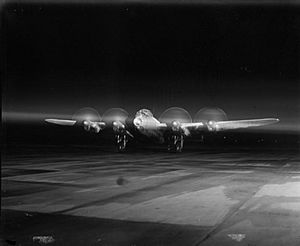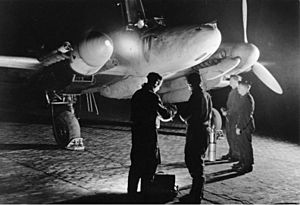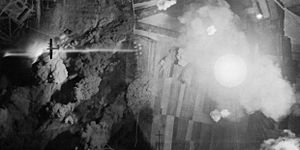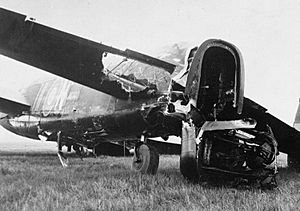Bombardment of Mailly-le-Camp facts for kids
Quick facts for kids Bombardment of Mailly-le-Camp |
|||||||
|---|---|---|---|---|---|---|---|
| Part of Second World War | |||||||
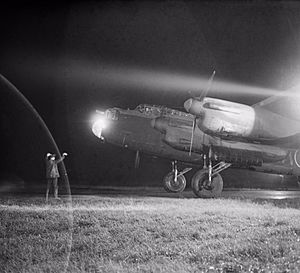 The Avro Lancaster at the completion of a mission |
|||||||
|
|||||||
| Belligerents | |||||||
| Commanders and leaders | |||||||
| unknown | |||||||
| Strength | |||||||
| 346 Lancaster heavy bombers 14 Mosquito marker aircraft |
Approximately 60 nightfighters | ||||||
| Casualties and losses | |||||||
|
Air
|
Air
Ground
|
||||||
The Bombardment of Mailly-le-Camp was a special air raid by the British Royal Air Force (RAF) during World War II. It happened on the night of May 3-4, 1944. The target was a German tank training center in northern France. This mission was part of a bigger plan to weaken German forces before D-Day. D-Day was the huge Allied invasion of Normandy in June 1944.
The raid was given to a special group of RAF bombers called No. 5 Group. Another group, No. 1 Group, joined them. The base was thought to be easy to attack. However, problems with the plan and radio messages caused delays. German night fighters found the bombers waiting in the sky. Even though the training camp was destroyed, many British planes were lost.
Contents
Planning the Attack on Mailly-le-Camp
Why Mailly-le-Camp Was Chosen
The military base at Mailly was in northern France, about 80 miles east of Paris. It was built in 1902 for the French army. In the 1930s, it was used for training tanks. After France fell to Germany in 1940, the Germans took it over. They used it to train new crews for their tank units. These units were replacing tanks and soldiers lost in battles on the Eastern Front.
In late 1943, the French Resistance (a secret group fighting the Germans) was asked to watch the base. They provided detailed maps and lists of German units there. In spring 1944, they reported that parts of the 21st Panzer Division had arrived.
In April 1944, Bomber Command changed its focus. Instead of bombing German factories, they started attacking German military sites in occupied Europe. This new plan was called the Transport Plan. It was meant to prepare for and support the D-Day invasion. On May 2, 1944, the Mailly base was chosen as a target. The mission was given to 5 Group, led by Ralph Cochrane.
How 5 Group Planned the Bombing
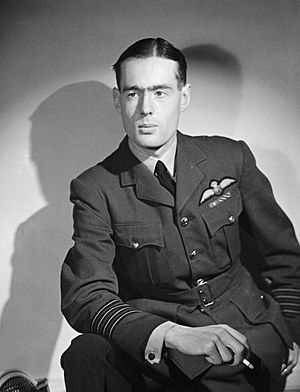
5 Group had a very accurate way of marking targets from low altitude. Their leader, Leonard Cheshire, was a master at this. Bomber Command chief Arthur Harris gave 5 Group more freedom after they proved their method. They even got their own special marking planes, called Mosquitos.
The mission was run the 5 Group way. Instead of a "Master Bomber" guiding everyone, there was a "Marker Leader" (Cheshire) and a "Main Force Controller" (Laurence Deane). Cheshire would fly his Mosquito very low to mark the target. Other planes, mostly Lancasters, would then bomb the marked area.
The planners hoped to hit the 21st Panzer Division while the soldiers were in their barracks. Curfew was midnight, so Cheshire was to drop his markers just after 12:00 AM. To make the attack stronger, 5 Group asked 1 Group to join them.
There were some problems from the start. 5 Group prepared quickly, and not everyone fully understood the plan. Also, there were issues with radio communication that became clear only during the raid.
The Mission Plan Details
The bombers flew south from England, climbing as they went. They crossed the English Channel and entered France near Dieppe. They then flew across northern France, slowly losing altitude. Their goal was an assembly point 15 miles north of Mailly-le-Camp. This point would be marked with yellow flares by special Mosquitos.
From the assembly point, the bombers would fly south to the target. They would drop their bombs on the markers and then leave the area. The route back to England was also carefully planned.
Bombing the target was tricky because a French village was nearby. The RAF wanted to avoid harming French civilians. So, they decided to bomb from a lower height (6,000 to 8,000 feet). This would make their bombing more accurate. Each heavy bomber carried a huge 4,000-pound "cookie" bomb, plus 15 or 16 smaller 500-pound bombs. No incendiary (fire-starting) bombs were used.
The mission was supposed to happen like this:
- Just before midnight, Mosquitos would drop special flares over Mailly-le-Camp.
- At 12:01 AM, Cheshire would mark the east side of the camp with red flares.
- After checking the markers, Cheshire would signal the Main Force Controller, Laurence Deane.
- Deane would then tell the first wave of 173 Lancasters from 5 Group to bomb.
- After this first wave, bombing would stop. Cheshire would mark the west side of the camp.
- At 12:20 AM, the second wave of 140 Lancasters from 1 Group would be called in to bomb.
- By 12:26 AM, all planes should have left the target area.
An assembly point was set up north of Mailly. Mosquitos would keep it marked with yellow flares. Arriving bombers would circle there until they got the signal to attack.
The weather forecast was clear skies and a bright moon. Everyone expected an easy mission. However, there were four German night fighter bases close to the assembly point. About 60 German night fighters could be ready to fly. Delays near the target could be very dangerous.
The Raid on Mailly-le-Camp
Flight to the Target
At 9:45 PM, ten squadrons from 5 Group took off, followed by seven from 1 Group. They flew south, gaining height. They crossed the Channel at 12,000 feet to avoid German anti-aircraft guns. Then, they slowly dropped to 7,000 feet as they approached the assembly point.
About 20 minutes later, Cheshire and his four Mosquito marker planes took off. They flew separately, each navigating to the target. They would catch up to the main bomber force and arrive early. Cheshire even flew over a German night fighter base to trick them into thinking he was just a lone intruder.
At the assembly point, Mosquitos dropped yellow flares. The heavy bombers were supposed to circle these markers until the target was ready. The planes from 5 Group arrived first and began circling. They were stacked at different heights, 100 feet apart.
Marking the Target
The night was clear. Cheshire arrived on time and dropped his red target flares at the east end of the camp. The markers were accurate and burned brightly. Cheshire radioed Deane, the Main Force Controller, to start the attack.
But Deane had trouble hearing Cheshire. He saw the markers were good and told his radio operator to send the order to attack. Then he waited for the bombing to begin. Nothing happened. No one received his message.
Chaos at the Assembly Point
While the bombers circled, German night fighters started to arrive. They slipped in among the circling Lancasters. Planes began to be shot down. Pilots became impatient and broke radio silence, complaining about the delay. Deane heard them but stuck to his orders to stay silent. He kept telling his radio operator to repeat the attack order. After 5 or 6 minutes, some 5 Group planes started their bombing runs. It's not clear how, since no one heard Deane's messages.
Even a few minutes' delay was costly. The air battle over the assembly point was short but fierce. Crews saw four or five Lancasters falling at once. One wireless operator saw six explosions nearby, realizing Lancasters were being blown apart.
More planes arrived as 1 Group joined the circling bombers. One pilot compared the scene to a "swarm of gnats." The sky was full of Lancasters. German Messerschmitts and Junkers fighters flew through them, shooting down planes.
Since no one heard Deane, his deputy, Neville Sparks, took over. He started signaling the force to attack. To make things worse, an American radio station was broadcasting swing music on the same frequency the RAF was using! Despite the problems, 5 Group bombers started hitting the target accurately.
Cheshire saw many planes going down. He knew German night fighters were everywhere. He tried to call off the whole attack and send the bombers home. But the main force couldn't hear him. They weren't used to his radio method.
By 12:16 AM, 5 Group planes should have finished bombing. But almost two-thirds of the first wave were still circling. Still, it was time to mark the target again. Sparks tried to stop the bombing, but he was only partly successful.
Marking the Western End
As the time for the second marking came, two Mosquito pilots, Fawke and Keane, prepared to mark the west end. Deane, not realizing this, tried to refresh the original markers on the east end. He flew his Lancaster low over the target. He expected a pause in the bombing, but it didn't happen. His plane was violently shaken by bombs exploding below. He later realized 1 Group planes were carrying 4,000-pound bombs, which needed a 4,000-foot safety height. Deane seemed unaware that all bombers carried these large bombs.
Cheshire saw the destruction at the assembly point. He wanted the whole force to just drop their bombs on the east end. But he couldn't reach Deane. So, Cheshire ordered Kearns and Fawke to mark the west end as planned. Their Mosquitos were also violently shaken by the explosions. They dropped their flares from higher altitudes to survive. Kearns barely made it out.
Bombers Finally Attack
As Kearns left Mailly, the target area was cleared. Most of 5 Group and all of 1 Group were still circling. Finally, the order to attack came through. It was 12:24 AM, 15 minutes late. One pilot said the waiting area looked like a horse race starting line. The heavy bombers rushed to the target, dropping all their bombs. The radios went silent as the planes headed away.
Inside the camp, the second wave of bombing was much stronger. Soldiers hid in trenches, but the huge 4,000-pound bombs caused the trenches to collapse. Survivors had to dig themselves out. After 15 minutes, the bombing lessened. Officers shouted orders to fight fires. But then, a third, even more intense bombing began, catching many soldiers in the open.
From the nearby French town, the sky was shocking. Everything was lit up, and there was a constant hum of planes. Explosions were loud, and it looked like a huge air battle was happening.
The German tank training camp at Mailly-le-Camp was destroyed. Many buildings, vehicles, and tanks were lost. Many instructors and soldiers were killed or wounded. This was the first time these German soldiers experienced such heavy bombing.
As the bombers flew home, German fighters still pursued them. Some battles continued all the way to the coast. Deputy Controller Sparks' plane was shot down as he left the target area.
Aftermath of the Raid
The mission to Mailly-le-Camp was part of the plan to weaken German defenses before D-Day. The bombing was accurate. About 1,500 tons of bombs were dropped, causing massive damage. The training base was almost completely leveled. Many buildings, vehicles, and tanks were destroyed. Over 200 German instructors and soldiers were killed, and 156 were wounded.
However, the success came at a very high cost for the RAF. 42 Lancasters and their crews were lost. Another Lancaster was damaged beyond repair after returning to base. 5 Group lost 14 bombers, and 1 Group lost 28.
The main problem was communication. Deane's radio was off-frequency, so his messages were unreadable. Many crews didn't even know they were supposed to get instructions by radio. An American radio broadcast on the same frequency made things worse.
The delay of just a few minutes allowed German night fighters to attack the circling bombers. The loss rate was 11.6%, which was extremely high. This was as bad as raids on heavily defended German cities like Berlin. But these losses happened much faster, mostly in 30 minutes over the assembly point. Some German fighter pilots shot down many planes in a short time.
Very few French civilians were harmed. Investigations confirmed no bombs fell on nearby French towns. The few civilian deaths were caused by falling debris from destroyed aircraft.
A week later, another 5 Group mission to Lille also had problems and high losses. After these two missions, the rule for missions to France (where fewer losses were expected) was changed.
Critics used the Mailly-le-Camp raid to say Cheshire's low-level marking method wouldn't work for large bomber forces. But Cheshire was only in charge of marking, which he did accurately. The delay was due to confusion and communication failures. Cheshire later said, "You have got to have good communications."
After the raid, 1 Group's commander regretted joining the mission. His small marker unit was later disbanded.
Jack Currie, a former bomber pilot, wrote about the bravery of the crews: "What has to be remembered about Mailly-le-Camp is that, with all hell bubbling up around them... the great majority of captains and crews gritted their teeth and waited for the order." He said they won a greater battle by keeping their faith and tradition.
Some airmen who were shot down survived. Deputy Controller Ned Sparks and his crew parachuted to safety. Sparks joined the French Resistance and returned to England seven weeks later. His return was a big surprise, and he was celebrated.
Most of the 258 airmen who died are buried in Mailly-le-Camp and nearby villages. An annual service is held there to remember the airmen, French civilians, and the French Resistance.
Images for kids



